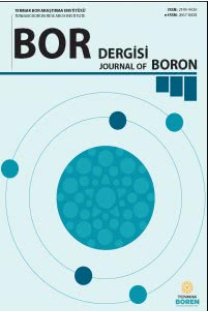Resin type and resin diameter effect on the adsorption of boron isotopes
AbstractChromatography is a technique for molecular partition in which a fluid (mobile phase) carries the material containing the mixture to be separated (sample) past or through a solid or gel (stationary phase) contained in a vessel. The stationary phase has characteristics that delay the passage of some molecular components of the sample more than the passage of others causing them to separate in the mobile phase emerging from the column. The selection of stationary phase is one of the key factors for reaching an optimum separation in chromatographic applications. The scope of this work is to investigate the effect of resin type and diameter from the point of Langmuir adsorption isotherm parameters of 10B and11B isotopes for chelating resin and weak base anion exchange resin.Keywords: Chromatography, Stationary Phase; Boron Isotopes; Langmuir Adsorption Isotherm Parameters
Keywords:
-,
___
- [1] Sewell P., Clarke B., Chromatographic separations, New York, Wiley, 1988.
- [2] Jonsson J. A., Chromatographic theory and basic principles, New York, Marcel Dekker, 1987.
- [3] Braithwaite A., Smith FJ., Chromatographic methods. 5th ed. London Blackie, 1996.
- [4] Skoog D. A., West D. M., Holler F. J., Crouch S. R., Fundamentals of analytical chemistry. 8th ed. Thomson-Brooks Cole, Belmont, 2003.
- [5] Lim B. G., Ching C. B., Tan R. B. H., Determination of competitive aIsotherm of enantiomers on a dual-site adsorbent, 213-228, 1995.
- [6] Ravald L., Fornstedt T., Theoretical study of the accuracy of the elution by characteristic points method for Bi-Langmuir isotherms, 13th International Symposium on Preparative and Process ChromatographyJournal of Chromatography A, 908, 111–130, 26 January 2001.
- [7] Gentilini A., Migliorini C., Mazzotti M., Morbidelli M., Optimal operation of simulated moving-bed units for non-linear chromatographic separations: II. Bi-Langmuir Isotherm, Journal of Chromatography A, 805, 37–44, 1 May 1998.
- [8] Umpleby R. J., Baxter S. C., Chen Y., Shah R. N, Shimizu K. D., Characterization of molecularly imprinted polymers with the Langmuir−Freundlich isotherm, August 23, 2001
- [9] Guiochon G., Felinger A., Shirazi D. G. G., Fundamentals of preparative and nonlinear chromatograph, Second Edition, 67-216, 2006.
- [10] Hashem N. N., Optimization of chiral separation of nadolol by simulated moving bed technology, pHD Thesis, The University of Western Ontario, December 2012.
- 11] Ching C. B., Ho C., Ruthven D. M., An improved adsorption process for the production of high-fructose syrup, AICHE Journal, 32, 1876–1880, 1986.
- [12] Choi Y. J., Han S. K., Chung S. T., Row K. H., Separation of racemic bupivacaine using simulated moving bed with mathematical model, Biotechnology and Bioprocess Engineering , 12, 625-633, 2007.
- [13] Asnin L., Kaczmarski K., Guiochon G., The adsorption of naproxen enantiomers on the chiral stationary phase whelk-O1 under reversed-phase conditions: The effect of buffer composition,Journal of Chromatography A, 1217, 7055-7064, 2010.
- [14] Sağlam G., Manufacture of simulated moving bed and annular chromatography systems: Assessment of BSA purification performance in annular chromatography, Master Thesis, Hacettepe University, Chemical Engineering Department, 2009.
- [15] Lorenz K., Maga J., Use of gas-liquid chromatography for quality evaluation of dry egg products, Journal of Food Science, 36 (6) 936–939, September 1971.
- [16] Kim J. I. I., Hong S. B., Row K. H., Effect of particle size in preparative reversed-phase high-performance liquid chromatography on the isolation of epigallocatechin gallate from Korean Green Tea, Journal of Chromatography A, 275–280, 2002.
- [17] Liu H., Finch J. W., Lavallee M. J., Collamati R. A., Benevides C. C., Gebler J. C., Effects of column length, particle size, gradient length and flow rate on peak capacity of nano-scale liquid chromatography for peptide separations, Journal of Chromatography A, 1147, 30–36, 2007.
- [18] Poe D. P., Schroden J. J., Effects of pressure drop, particle size and thermal conditions on retention and efficiency in supercritical fluid chromatography, Journal of Chromatography A, 1216, 7915–7926 , 2009.
- [19] Unger K. K., Lamotte S., Machtejevas E., Column technology in liquid chromatography, liquid chromatography: Fundamentals and instrumentation, Chapter 3, 41-86, Elsevier, 2013.
- [20] Sonoda, A., Makita, Y., Ooi, K., Takagi, N., Hirotsu, T., pH-dependence of the fractionation of boron isotopes with N-methyl-D-glucamine resin in aqueous solution systems, Bulletin of the Chemical Society of Japan, 73, 1131-1133, 2000.
- [21] Kakihana, H., Kotaka, M., Satoh, S., Nomura, M., Okamoto, M., Fundamental studies on the ionexchange separation of boron isotopes, Bulletin of the Chemical Society of Japan, 50, 158-163, 1977.
- [22] Sonoda, A., Makita, Y., Hirotsu T., Boron isotope fractionation in column chromatography with glucamine type resins, Journal of Nuclear Science and Technology, 43,437-440, 2006.
- [23] Sonoda, A., Makita, Y., Hirotsu T., Boron isotope fractionation in column chromatography with glucamine type fibers, Journal of Nuclear Science and Technology, 6, 117-121, 2008.
- [24] Sakuma Y., Aida M., Okamoto M., Kakihana H., Boron isotope separation by ion exchange chromatography using weakly basic anion exchange resin, Bulletin of the Chemical Society of Japan, 53, 1860-1863, 1980.
- ISSN: 2149-9020
- Yayın Aralığı: Yılda 4 Sayı
- Başlangıç: 2016
- Yayıncı: TENMAK Bor Araştırma Enstitüsü
Sayıdaki Diğer Makaleler
Mustafa Barış, Tuncay Şimşek, Hakan GÖKMEŞE, Adnan AKKURT
Boron isotopes enrichment via continuous annular chromatography
Characterization of W2B nanocrystals synthesized by mechanochemical method
Tuncay ŞİMŞEK, Mustafa BARIŞ, Adnan AKKURT, Hakan GÖKMEŞE
Yazar Kılavuzu/Author Guidelines
Resin type and resin diameter effect on the adsorption of boron isotopes
Ahmet R ÖZDURAL, Gonca SAĞLAM, Zeynep AKTOSUN, Gülşah ÖZÇELİK
